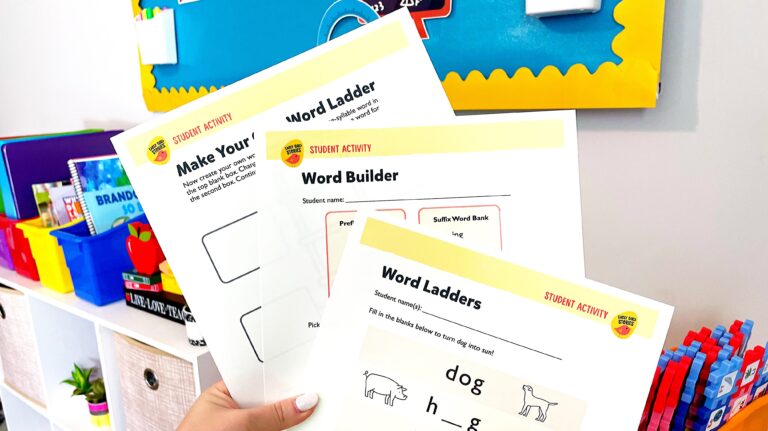Sweating over needing to teach a demo lesson as part of your new-teacher interview process? We’ve all been there! That’s why we’ve gathered this list of must-have elements to include in a demo lesson. These are the lesson elements interviewers will be looking for, and including them will show that you know your stuff. Plus, we’ve included some ideas for demo lesson topics toward the end of this article!
1. Hook
Make sure you start off your lesson with an engaging hook. It doesn’t have to be very long, it just has to be interesting and connected to the learning goal. It can be a quick story, an interesting question, or maybe even a short picture book or picture. Keep it simple and engage your interviewer audience.
For example: If you’re teaching a lesson about about fractions, introduce the lesson by talking about pizza and how many slices make up the whole pizza. Make it fun and relatable.
2. Standards-Aligned Learning Goal
You need to create a learning goal that is aligned with the standard that you’re teaching. The learning goal also has to be measurable and objective, so use verbs like explain, describe, identify, and the like. Use the language from the content standard and make it a part of your learning goal too. This will show that you understand the standard that is being taught and how to use it in a learning goal.
For example: Let’s say you’re teaching CCSS.RL.3.3—Describe characters in a story (e.g., their traits, motivations, feelings) and explain how their actions contribute to the sequence of events. A learning goal might look like this: “We are learning how to describe a character’s traits, motivations, feelings, and actions.” A second learning goal for this standard could be “We are learning how to explain how the character’s actions contributed to the sequence of events.”
3. Modeling and Metacognition
Show the interview panel that you know how to teach a skill by modeling it during your lesson. While you’re modeling how to do the skill (like finding a common denominator or determining the main idea), also use metacognition. Think out loud about your thinking and demonstrate to the panel how you will think out loud with your future students.
For example: Let’s say you’re teaching about determining the main idea. You might think out loud by saying that you didn’t quite understand the main idea the first time you read the passage, so you have to read it again. Then literally read the passage again and think out loud about how you focused in on key details to determine the main idea.
4. Check for Understanding
Another element for teacher demo lessons is making sure you’re checking your students’ understanding. When you check for understanding during your lessons, you’re showing that you’re monitoring your students’ progress toward meeting the learning goal. It’s also an opportunity to show how you’ll adjust the pacing of your lesson if students aren’t understanding the skill you’re teaching.
For example: You can do this by simulating that your interview panel has whiteboards and asking them to show their answers on their boards. If you’re teaching a group of students, you can pass out whiteboards or use sheet protectors with a white paper inside. You can also check for understanding by walking around as students write answers down or by listening to student conversations during think-pair-share moments.
5. Differentiation
When you’re teaching your lesson, make sure you use differentiation. Adding this to your lesson will show the interviewers that you know how to scaffold for students who need support and also extend the learning for your students who need more challenge.
For example: You can ask varying levels of questions while you’re checking for understanding. Consider bringing different levels of independent practice and end the lesson by calling a small group over to reteach, after you’ve noticed the students who need more support. Some other examples of differentiating during your lesson could be using various leveled passages or math tasks during the lesson, or showing that you know how to adjust during the lesson if students aren’t getting the skill right away.
6. Depth of Knowledge Questions
One of the other important elements for teacher demo lessons is using depth of knowledge (DOK) questions. While you ask students questions during the lesson, use DOK questions to make sure students are being challenged. The DOK questions vary from Level 1 to Level 4, Level 4 being the most in-depth and thought-provoking. Incorporating this type of questioning into your lesson will show the interview panel that you will challenge your students with thoughtful questioning.
For example: Level 1 is recall, so ask literal questions that students can answer based on their book or other printables that are in front of them. Questions that are Level 2 are more concept-oriented, so ask questions that make students distinguish items or determine cause and effect. Level 3 is strategic thinking. Students might have to cite evidence or come up with an argument when answering these types of questions. Finally, Level 4 is extended thinking. These questions challenge students to design, make connections, or prove a concept.
7. Opportunities for Student Talk
Don’t be the only one who’s talking during the lesson. Invite students (or the interview panel) to turn and talk, think-pair-share, or use A/B partnering to share ideas during the lesson. Students might work together on a question during the check-for-understanding portion too.
For example: If you’re teaching a math lesson, have students pair up to work on one of the problems together.
8. Closure Questions
Always ask students at the end of the lesson what the learning goal was. Students should be able to tell you what they were working toward when the lesson is over. You can also ask students additional questions that connect to the learning goal. They can be “how” or “why” questions or questions based on DOK.
For example: Closure questions can be something like “Why is it important to _?” or “How do you _?” Consider asking students to fill out an exit ticket so they have one more opportunity to show what they learned in the lesson.
9. Matching Independent Practice
If you’re going to bring an independent practice task to pass out at the end of your lesson, it must align with the learning goal. Come prepared with various levels of independent practice and be creative in how you want the students to show what they’ve learned.
For example: If you’re teaching a math lesson, you can bring a handout of math problems, task cards, or an interactive activity that’s done online. If you’re teaching an ELA lesson, bring a reading passage, writing task, or literacy activity for students to demonstrate their understanding. Just make sure it relates back to your learning goal.
10. Personality
One of the most important elements for teacher demo lessons is to show your personality. Have fun, be yourself, and let your passion for teaching shine through!
For example: Smile, make silly jokes, make connections to your daily life, and give a glimpse of how you are as a human. Be relatable.
Here are 10 topic ideas for elementary demo lessons:
- Determining main idea
- Comparing fractions
- Citing evidence
- Rounding numbers
- Comparing/contrasting story elements
- Academic vocabulary
- Comparing decimals
- Finding the perimeter
- Describing characters
- Determining author’s point of view
Here are 10 topic ideas for secondary demo lessons:
- Annotating text
- Figurative language
- Grammar
- Story structure
- Poetry analysis
- Square roots
- Coordinating planes
- Factoring by grouping
- Slope
- Percentages
For more new-teacher inspiration or ideas for a demo lesson, check out the 10 Best Books for New Teachers.
Never miss out on teaching ideas, opportunities for a demo lesson, and new-teacher support when you subscribe to our newsletters.


